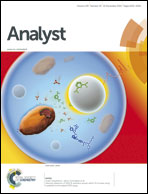A supramolecular nanobiological hybrid as a PET sensor for bacterial DNA isolated from Streptomyces sanglieri†
Abstract
The development of a rapid, label free, cost effective and highly efficient sensor for DNA detection is of great importance in disease diagnosis. Herein, we have reported a new hybrid fluorescent probe based on a cationic curcumin–tryptophan complex and water soluble mercapto succinic acid (MSA) capped CdTe quantum dots (QDs) for the detection of double stranded DNA (ds DNA) molecules. The cationic curcumin–tryptophan complex (CT) directly interacts with negatively charged MSA capped quantum dots via electrostatic coordination, resulting in photoluminescence (PL) quenching of QDs via the Photoinduced Electron Transfer (PET) process. Further, addition of ds DNA results in restoration of PL, as CT would intercalate between DNA strands. Thus, this process can be utilized for selective sensing of ds DNA via fluorescence measurements. Under optimized experimental conditions, the PL quenching efficiency of QDs is found to be 99.4% in the presence of 0.31 × 10−9 M CT. Interestingly, the regain in PL intensity of QD–CT is found to be 99.28% in the presence of 1 × 10−8 M ds DNA. The detection limit for ds DNA with the developed sensing probe is 1.4 × 10−10 M. Furthermore, the probe is found to be highly sensitive towards bacterial DNA isolated from Streptomyces sanglieri with a detection limit of 1.7 × 10−6 M. The present work will provide a new insight into preparation of bio-inspired hybrid materials as efficient sensors for disease diagnosis and agricultural development.


 Please wait while we load your content...
Please wait while we load your content...